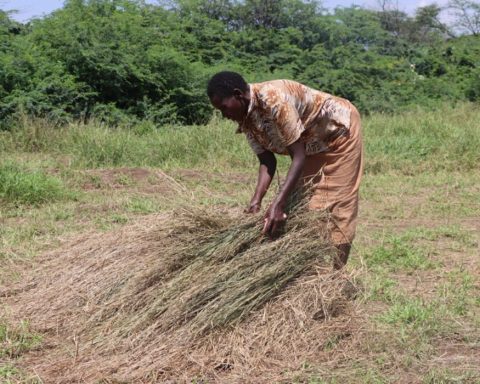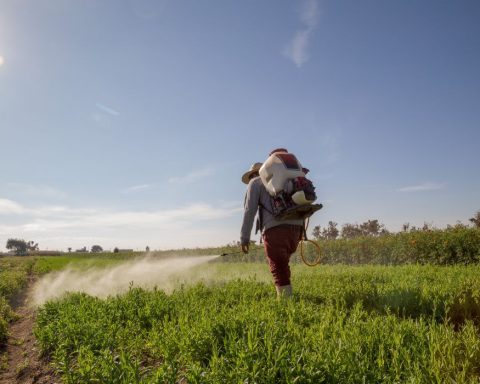A convoy of tractors was making its way to a Dutch government building in February when Tesla CEO Elon Musk tweeted out his support for farmers revolting against the EU’s regulatory push to drive down climate emissions: “I’m pro-environment, but I support the farmers! Farming has no material effect on climate change.”
The online reaction was swift, with stats, charts, links and memes filling replies from all sides. While overwhelming scientific findings consider agriculture, particularly livestock farming, a significant source of planet-warming greenhouse gas emissions, conflicting measurements, marketing and misinformation have been making the facts more difficult to decipher. And it appears the meat industry has been capitalizing on all the confusion.
Ever since the UN’s Food and Agriculture Organization (FAO) first dropped a bombshell report on the “enormous” ecological impact of livestock farming back in 2006, the trillion-dollar global meat industry has been on the defensive. The report concluded that cars and coal plants weren’t the only ones spewing out planet-warming greenhouse gases: cattle-rearing was also a top contributor to the climate crisis. The backlash was intense, with FAO staffers recently revealing that pressure from Big Ag led to their work being censored and undermined.
Two decades later, the meat and dairy industries have spent millions on counter-research and marketing, including creating an “MBA” for beef industry advocates. The world’s biggest meat-packers have announced net-zero targets, as the industry tries to reassure the public that despite the urgency of the climate emergency, there’s no need to cut back on our burgers and steaks. Even beef can be part of a balanced planet-friendly diet, they claim.
In one of the latest attempts to quell consumer demand for more sustainable protein, Tyson Foods, America’s largest beef exporter, launched a “climate-friendly” product line, Brazen Beef, under the slogan “Better beef, better planet.” With the help of US$61 million in grants from the US Department of Agriculture, cattle are enrolled in Tyson Foods’ “Climate-Smart Beef Program,” according to the product website, “for emission reduction from pasture to production.” As Tyson’s VP of fresh meats marketing told Progressive Grocer magazine, “We are trying to be upbeat and different, with something that speaks definitively to [millennial and Gen Z consumers].”
And Tyson isn’t the only one banking on planet-friendly meat to keep consumers coming back to the butcher. Walmart Canada stocks 2.5 million pounds of beef patties certified by the Canadian Roundtable for Sustainable Beef. Nestlé is paying ranchers for regenerative grazing practices that get sold as carbon credits. General Mills makes a regenerative-beef protein bar that it claims offsets 80% of its greenhouse gas emissions through regenerating soil practices.”
The practice of branding meat as climate-friendly isn’t new. Many of Canadian meat giant Maple Leaf Foods’ products have carried a “carbon zero” label since 2019, when it declared itself to be the “world’s first major carbon neutral food company.” Its Greenfield Natural Meat pork products are cleverly marketed as part of a “low carb(on) diet,” including “planet-based” bacon.
But while these multinationals have made apparent efforts to reduce their environmental impact – from limiting deforestation in their tropical supply chains to retrofitting plants with LED lighting, and even restoring a few thousand acres of grasslands – there is no indication they have reduced production of the products at the heart of the climate quagmire. And as emissions from the world’s 20 largest publicly listed meat and dairy companies keep ticking upwards while global meat consumption swells, some major meat producers and retailers are playing with the metrics that measure them – and lobbying governments to help them make climate-friendly claims that have the appearance of adding up.

Skewering the stats
In the air-conditioned corridors of Dubai’s COP28 climate summit in December, a record-breaking number of meat and dairy delegates descended to soft-sell a new way of measuring their sector’s contribution to the climate crisis. The livestock industry is responsible for nearly a third of heat-trapping methane (the world’s second-biggest driver of climate change). To date, the UN and global governments have been measuring “global warming potential” (GWP) over a 100-year time frame using a metric called GWP100. Since methane breaks down in the atmosphere much sooner than carbon dioxide, which will warm the planet for centuries, an additional metric known as GWP* was proposed by Oxford University scientists in 2016 that factors in methane’s potent short-term impacts, taking 2016 methane emissions as baseline. With one caveat: it was never intended to be used as the sole way to measure animal emissions. But the meat and dairy industry is eating it up.
“Imagine a house is on fire, and someone is actively pouring gas on the fire. They then pour a little less gas and want credit for doing so, despite still feeding the fire. Perhaps they claim they are now ‘fire neutral,’” writes University of California, Davis, researcher Caspar Donnison, co-author of a study published in Environmental Research Letters in December on the use of GWP* in climate-neutral livestock research. “That is more or less what some influential supporters of the livestock industry have done.”
A report by Changing Markets, a U.K.-based foundation, found that, using 2021 as the baseline, Tyson could “use GWP* to claim that a 30% reduction in emissions by 2030 means it is removing 82.6 million tonnes of carbon dioxide equivalent from the atmosphere a year, yet calculations using GWP100 suggest it would still be emitting 58.5 million tonnes annually – similar to the annual emissions of Peru.”
Nusa Urbancic, director of the Changing Markets Foundation, said that using 2021 as the baseline means “GWP* will penalise poor countries that are expanding livestock production from a low base while rewarding the world’s biggest industrial livestock producers with millions of heads of cattle.”
In the case of Tyson’s Brazen Beef, the metrics have yet to be made public. How Tyson got to the claim of “the first climate friendly beef with 10% greenhouse gas reduction” – becoming the first meat company to use the USDA-backed climate-friendly label – remains unclear. “In order to claim a 10% reduction, you need to establish scientifically a baseline that everyone agrees is the common amount that beef produces,” New York University environmental scientist Matthew Hayek explains. “There doesn’t seem to be any data that the company itself, or the government who it created that certification in conjunction with, is able to provide.”
Corporate Knights reached out to the USDA and Brazen’s certifier, Where Food Comes From, but reps directed us back to Brazen Beef to elaborate “if they choose.” Tyson Foods did not respond.
Either way, Brazen has critics raising the question: should a burger that still generates 90% of the emissions of a regular burger be allowed to call itself climate-friendly?
Regenerative reset
In the face of mounting pressure to get a handle on food systems’ enormous emissions, Big Ag, Big Food and Big Meat have all been leaning into climate-smart agriculture, aka regenerative agriculture or carbon farming, to save the day. Big Meat, in particular, has a hefty amount of emissions to draw down, and they’re hoping to sequester as much as they can into the soil, particularly the rich soil under ranch grasslands. Whether it’s Burger King investing in grassland projects or Maple Leaf, Nestlé and Brazil’s JBS (the world’s biggest meat-packer) buying carbon offsets from farmers that are paid to shift to regenerative practices, bucolic images of animals grazing in the open air are being used to lull conscious consumers into believing that buying meat can be beneficial for the planet.
But quantifying just how much carbon is drawn into the soil when every company uses different definitions of “regenerative” has been messy and the subject of heated debate, with some meat advocates claiming that grass-fed beef, in particular, has little to no effect on climate change.
Then scientists in the Netherlands, the U.K. and Sweden began looking into it. In a mic-dropping study released in November, the researchers concluded that there is no plausible way for the global livestock industry to ever sequester enough carbon to offset its planet-warming emissions. In order to counter annual methane emissions from ruminants such as cattle, the authors explain, 135 gigatonnes (billion tonnes) of carbon would have to be returned to soils – a colossal challenge, equivalent to all the carbon lost as a result of agriculture over the last 12,000 years. Their conclusion: “The claim that ruminant systems can have a negative annual GHG balance via soil C-sequestration is overly optimistic and could be misleading.”
Don’t have a cow offset
Grasslands aside, for most meat and dairy companies, claiming carbon neutrality and getting to net-zero is still largely a matter of basic omission. To call itself carbon neutral, including its Greenfield Natural Meat line, Maple Leaf (which does not sell beef) says it “eliminated, reduced and neutralized” its Scope 1, 2 and a portion of Scope 3 greenhouse gas emissions. The problem is that Scope 3 emissions (those from raw materials, feed and ingredients it buys and emissions associated with packaging and distribution) account for about 88% of Maple Leaf’s total emissions, according to the company. That includes emissions from animals and meat purchased from suppliers. “In 2023, we purchased carbon offset credits from 16 projects that neutralized approximately 7% of our Scope 3 emissions,” Maple Leaf spokespeople tell Corporate Knights – specifically for products that carry the “carbon zero” marketing label. As NYU’s Hayek points out, the Scope 3 emissions that Maple Leaf doesn’t include are “the largest slice of their supply chain.”
According to a report by the Freedom Food Alliance (FFA) released this winter, Maple Leaf isn’t alone. “Over 90% of most major meat and dairy companies’ emissions – representing Scope 3 third party supply chain emissions – are mostly omitted from their climate goals.” That includes those of meatpacking giant JBS, who, according to the report, “continues to make ‘net zero by 2040’ statements despite the National Advertising Review Board advising to discontinue this misleading claim,” along with marketing phrases like “Bacon, chicken wings and steak with net zero emissions. It’s possible.” In February, New York Attorney General Letitia James sued JBS, alleging that the company made deceptive statements in presentations, ads and on its website regarding its climate commitments. JBS denied the allegations.
The smoke and mirrors use of “net-zero” is just one of the tactics Big Meat uses to “deny, derail, delay, deflect and distract” meaningful discussion, as the FFA lays out. Meanwhile, the meat industry’s efforts have been focused not only on boosting their own products, but also on turning consumers away from plant-based meat alternatives. During the pandemic, brands like Beyond Meat and Impossible Foods surged in popularity. Touted as more sustainable and ethical, their sales soared. But by 2022 the narrative had shifted. Skepticism grew as critiques around the “ultra-processed” ingredients in plant-based options gained traction.
Full-page ads were taken out in major newspapers by a PR company working for the meat industry, which also ran Super Bowl spots in select markets, all to turn people off foreign-sounding ingredients in “synthetic” meat. The tactics used to dissuade consumers from turning to alternatives worked to complement the meat industry’s move to market its products as climate-friendly.
Rhetoric and marketing play a major role in the rebranding of meat as climate-friendly, explains Jason Hannan, editor of the book Meatsplaining: The Animal Agriculture Industry and the Rhetoric of Denial. “One of the most important contributions of environmental scientists and activists has been to introduce critical terms like ‘global warming,’ ‘climate change,’ ‘sustainability,’ ‘tipping points’ and ‘net-zero’ into our public vocabulary,” he says. “These terms have shaped how we assess governments and industries for their responsibility in our environmental and climate crises.” He notes that “carbon-neutral meat” has become a key term that the industry has appropriated to provide the veneer of environmental responsibility: “It’s like painting a gas station green and claiming it’s environmentally friendly.”
Over in Europe, lawmakers voted in January to outlaw the use of terms such as “climate neutral” for products that use carbon offsets, like, say, Maple Leaf’s bacon (which is not available in Europe). A few weeks later, the European Commission recommended ambitious new greenhouse gas emissions cuts. It had, however, quietly dropped a call for agriculture to curb non-CO2 emissions by at least 30%, compared to 2015, by 2040. All references to livestock farming, methane and a recommendation that Europeans eat less meat had also been taken off the table as a concession to protesting farmers.
It’s another indication that the meat industry has turned climate change into red-meat politics.
Adria Vasil is the managing editor of Corporate Knights.
Jessica Scott-Reid writes about animal welfare and plant-based food.
This story is part of our Spring 2024 Plant Power package.







